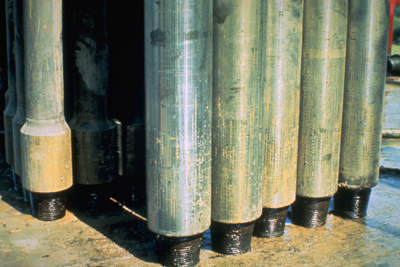1. n. [Drilling]
A component of a drillstring that provides weight on bit for drilling. Drill collars are thick-walled tubular pieces machined from solid bars of steel, usually plain carbon steel but sometimes of nonmagnetic nickel-copper alloy or other nonmagnetic premium alloys.
The bars of steel are drilled from end to end to provide a passage to pumping drilling fluids through the collars. The outside diameter of the steel bars may be machined slightly to ensure roundness, and in some cases may be machined with helical grooves ("spiral collars"). Last, threaded connections, male on one end and female on the other, are cut so multiple collars can be screwed together along with other downhole tools to make a bottomhole assembly (BHA). Gravity acts on the large mass of the collars to provide the downward force needed for the bits to efficiently break rock. To accurately control the amount of force applied to the bit, the driller carefully monitors the surface weight measured while the bit is just off the bottom of the wellbore. Next, the drillstring (and the drill bit), is slowly and carefully lowered until it touches bottom. After that point, as the driller continues to lower the top of the drillstring, more and more weight is applied to the bit, and correspondingly less weight is measured as hanging at the surface. If the surface measurement shows 20,000 lbm [9,080 kg] less weight than with the bit off bottom, then there should be 20,000 pounds force on the bit (in a vertical hole). Downhole MWD sensors measure weight-on-bit more accurately and transmit the data to the surface.
See related terms: bottomhole assembly, circulation system, collar, drilling fluid, keyseat, measurements-while-drilling, outside diameter, saver sub, sub, weight indicator
